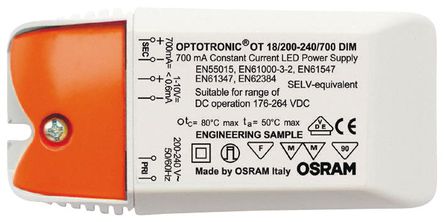I will read that and try to understand it tomorow, i need to learn this driver stuff urgently, but cannot find much usefull info ... I think most of our stuff has either 350, 500 or 700ma on it
Good luck. As eric is always saying, the difficulty is often in working out, from the labelling (or even 'spec sheet') what some of these drivers/power supplies/'transformers' actually do.
A load, like an 'LED' which needs to be driven by a constant current should (obviously) specify what the required constant current is, but also what (at least approximately) applied voltage is required to achieve that current. Hence, if the LED says "constant current source 500 mA, 10V), you need to use a a 500mA constant-current driver which has 10V within its range of 'capable' voltages - so, a 500mA 5V-15V constant-current driver would do, but, say a 12V-20V one would not.
You should not really attempt to use a constant current source to drive more than one load in parallel, since there is no guarantee of how the (total) constant current will split between the two or more LEDs. You
can use a constant current source to drive LEDs in
series if the 'total required voltage of the LEDs was within the capabilities of the driver - hence you could, for example drive two or three "500mA 6V" LEDs in series from a "500mA 10V-20V" constant current driver.
If dimming is involved, the whole thing becomes much more potential complicated and confusing!
Eric feels that constant current sources should be called drivers, and constant voltage ones 'power supplies' (or, heaven forbid.'transformers' or 'electronic transformers'). However, I don't think you can rely on manufacturers sticking to that convention.
Returning to the theory, in case it helps ... if you have, say, a "500mA, 5V-15V" constant-current driver, then it will attempt to put 500mA through any applied load, applying whatever voltage (within its range of capabilities) is necessary to put that current through the load. Hence, if the load is 10Ω, it will put 5V (10 x 0.5) across the load, for 20Ω it will apply 10V (20 x 0.5) and for 30Ω it will apply 15V - in all those cases, the current through the load would be 500mA (0.5A). However, since it cannot generate more than 15V ("5V-15V") if the load is greater than 30Ω, then the voltage will stay at 15V (can't go any higher), so the current will fall to below 500mA. So, in this case, it would be able (just) to run three 10Ω loads in series (total 30Ω, total voltage across the three at 500mA = 15V).
Kind Regards, John




